DATA:
Results we present here are based on the Journal Citation Report 2008 for the A&HCI that Loet Leydesdorff generated by aggregating the complete set for this year at the journal level (Leydesdorff & Akdag Salah 2010)[1]. The data retrieved for this task covers all the journals of A&HCI database, which amounts to 2,161 journals exactly. We would like to stress that from all scholarly production in arts and humanity fields, the A&HCI contains only journal publications from a restricted set of selected journals, and from these journals only a limited number of references builds the Journal Citation Report eventually use. For any further interpretation of the results we have to keep in mind that we talk about a very specific SAMPLE of citation behavior in the arts and humanities.
METHOD:
A citation is the mentioning of a document X by another document Y, where X can be of any type - an article, a book, an illustration, a musical score, etc. When a citation occurs, we say that X cites Y and at the same time Y is cited by X.
Figure 1:

In this work, we only consider citations between journal articles, so both X and Y are always articles in journals. Since an article belongs exactly to one journal, a citation of Y by X can be also interpreted as journal A (where article X appeared) citing journal B (where article Y appeared).
Figure 2:

When we choose the set of journals (usually constrained by the availability of data) and a time period, we use all the citations between the journals in our database and create a direct citation network.
Figure 3:
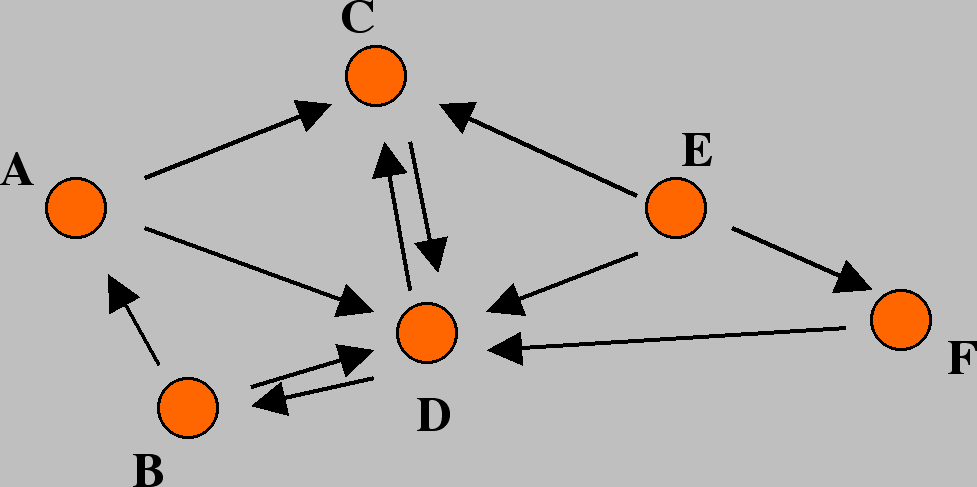
The citation network can be also represented as a matrix, where each row and column correspond to a journal.
Figure 4:
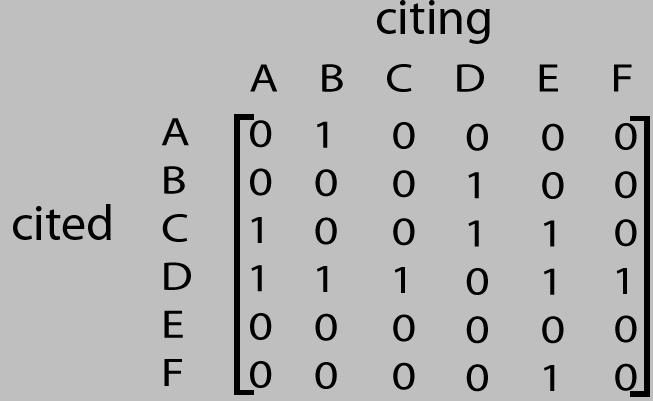
Looking at the column of journal D, we see that it has cited journals B and C, while looking at the row of journal D, we see that it has been cited by all other journals.
To analyze the function of scientific journals, we can investigate the "ego-network" of journals. To take a look at an egocentric-network we start with one specific journal X (the seed node) and ask for all incoming links to this node (i.e. all the journals citing journal X) or all outgoing links (journal X citing other journals). The journals in both sets form the two environments of this seed journal X, namely the citation impact environment and the knowledge base environment. For example at the matrix above (Figure 4), if we decide to take journal D as the seed journal, the journals {B,C and D} form the set in the citing dimension and the journals {A,B,C,E,F and D} in the cited dimension. Let us take the journal Leonardo as a real-life example. Leonardo has two citation environments:
- CITATION IMPACT ENVIROMENT: Journals that cite Leonardo during the investigated time period. One could call these journals the area of perception, impact and influence of the journal Leonardo. (The picture below is just an example and does not reflect the real citation impact environment of Leonardo).
- KNOWLEDGE BASE ENVIRONMENT: Journals that are cited by Leonardo during the investigated time period. (The picture below is just an example and does not reflect the real knowledge base environment of Leonardo).
Figure 5:
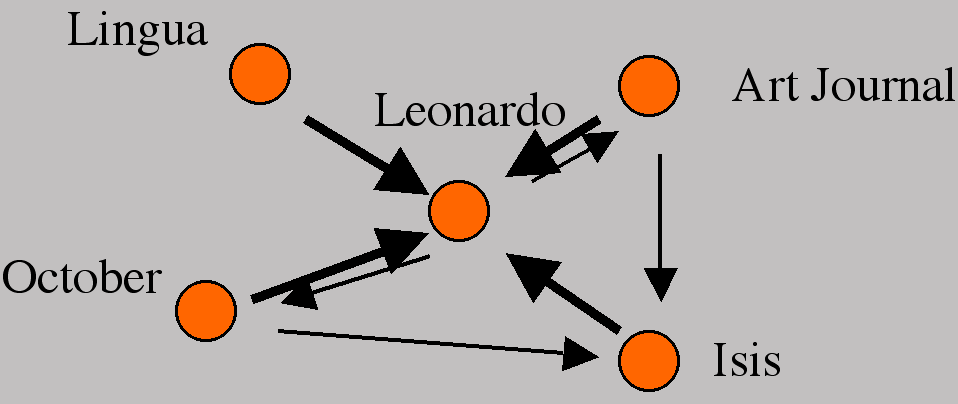
Figure 6:
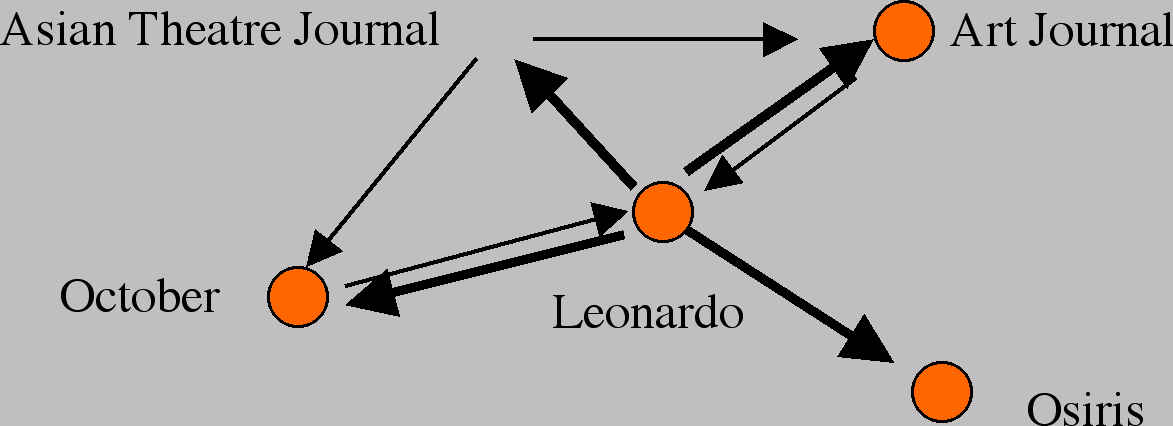
Both subsets of journals are not the same, but there is an overlap – the journals that appear in both environments cite Leonardo while at the same time they are cited by it.
Loet Leydesdorff developed an alternative approach to analyze these environments. This approach looks not at the direct citations between all journals in one of the environments, but at the similarities in journals’ citation patterns. The Leydesdorff method is a generalization of the bibliographic coupling method, which is based on the citation interaction between articles. According to the definition of bibliographic coupling, a link between two articles is established because they cite the same references; in our method a link between two journals is established because they cite (or are cited by) the same journals.
What is a citation pattern?
The simple way to explain the idea of a citation pattern is to use Figure 4. We can think of each row or column (=vectors) as the citation patterns of the corresponding journal. A more useful way is to think of each vector as the 'profile' of a journal. How a journal is cited (knowledge base profile) of a journal X reflects how it is perceived by other journals. Similarly, which journal is cited by the journal X (citation impact of journal X) reflects how journal X behaves.
How do we measure the similarity of two journals' citation patterns?
To measure the similarity of journals A and B's citation patterns, we look at the set of journals each journal A and B has cited, and we compare the two sets. We take into account how many times any journal is cited. If both A and B have cited the same journals and the same number of times their similarity equals 1. If they have never cited the same journal, then the similarity is 0. To be more precise, if we represent citation pattern of a given journal A (that corresponds to a column in Figure 7) as a vector, then the similarity between A and B is equal to the cosine between vectors for A and B.
Figure 7:

(Note: The vector for the first journal (A) has to be represented as a line vector while for the second the notion is a column vector, for correctness of the mathematical notation. The denominator is the product of the length of both vectors. This similarity measure is called cosinus of the angle between the two vectors in an abstract vector space where each journal is a vector.)
Here a caution is in order regarding the 'database', and the set of journals we extract from it in order to obtain two environments, i.e. the 'citation impact environment' and the 'knowledge base environment'. In our case, the database consists of 2,161 journals from the A&HCI, which we can present as a huge matrix with 2,161 columns and rows. In this database we have two options to analyze the ego-network of a journal:
- We can calculate the similarity patterns of all the journals in the database for both environments, and extract the similarity values of journals connected to our seed journal.
- We can extract two sets of journals according to their relations to our seed journal (i.e. either they are citing the seed journal, or they are cited by the seed journal), and create two sub-matrices. The matrices are further processed in order to calculate the similarity values of the journals in the given set. In this work, we applied the second option.
Figure 8:
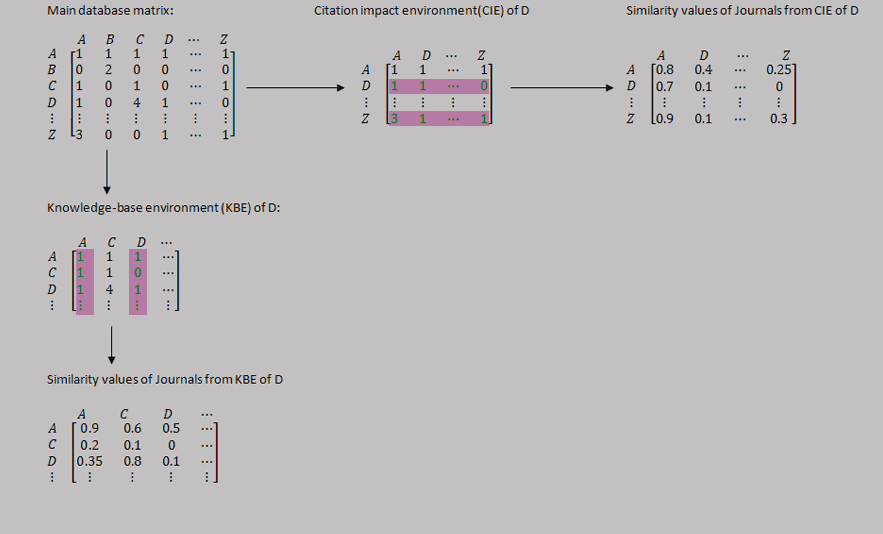
The difference between the knowledge base similarity values and the citation impact environment values depend on how we calculate them. We can calculate the similarity of all journal pairs. As you can see in Figure 8, we have the main matrix, out of which two sub-matrices are extracted. To find out all the similarity values for the knowledge base environment of D, we have to first normalize the columns of KBE of D and then multiply its transposition by itself. To obtain all the similarity values between all journals for citation impact environment we have to normalize rows of CIE of D and then multiply it by its transposition.[2]
We can now visualize our similarity matrices as networks by asserting that the presence of an edge between two journals depends on the similarity being higher than a pre-defined threshold value. For example, if the similarity between A and B is 0.15 and the threshold is set as 0.2, there will be no link between A and B. On the other hand, B and C will be connected, as their similarity is 0.36 [Figure 9].
Figure 9:
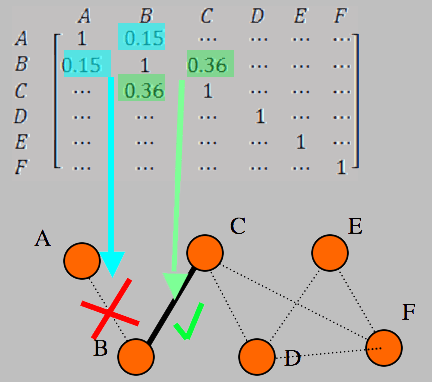
In this way, we have obtained the knowledge base (citing) similarity networks and the citation impact (cited) similarity networks for all journals in A&HCI 2008. These networks, along with the matrices (in Pajek file format) can be found in the JOURNALS section of this website.
While browsing these networks it is important to remember that the links are NOT direct citation links (direct information flows), but represent a similar citation behavior in both the citing and the cited direction (indirect information processing). For instance, in the citation impact environment of Leonardo journals are linked if they are cited together.
We assume that this "indirect" links represent functional similarities of journals in the system of scientific communication beyond volatile direct citation flows.
The position of the seed journal allows insights into interdisciplinarity and interface function of journals. However, the observer has to take into account that the networks and the position of the seed journal change over time. The one-year snapshot presented on this website gives only a first indication of a possible function, which requires further investigation with the help of longer time series and possibly also a combination of different network information such as direct citations; co-citations; and co-word analysis on journal level.
--------------
[1] Leydesdorff & Akdag Salah. Maps on the basis of the Arts &Humanities Citation Index: the journals Leonardo and Art Journal, and "Digital Humanities" as a topic, Journal of the American Society for Information Science and Technology 61(4) (2010) 787-801.
[2] If you want to learn more how matrices are multiplied, please check it here.